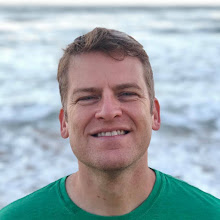On the return home, Sarah saw a pair of earrings in the airport that she thought I would like for mathematical reasons. She was right on! Any time circles get involved, you can pretty much bet things have an interesting mathematical interpretation, but these earrings are considerably rich for generating discussion. And lucky for Sarah, her mom bought them for her.
If we consider the outer circle as the boundary of the Poincare disk model of the hyperbolic plane, there are three horocycles and one h-circle in this earring. The horocycles are tangent to the boundary, or "circle at infinity", and the h-circle is floating in the interior. By h-circle, I mean residents of the hyperbolic plane would see it as a circle, that is a set of points a fixed distance from a center. The Euclidean center of the h-circle in the model (what you see as the circle center) doesn't coincide with the center of the circle the residents would perceive however - that only happens for h-circles having centers at the Euclidean center of the disk.
No geodesics (straight h-lines) are in these earrings, as those would be segments of circles orthogonal to the boundary of the disk. Two of the horocycles (one is the tiny circle with the stone in it) are tangent to each other, meeting at a single point. Noticing this reinforced their non-geodesic character to me, for if they were straight lines and met at some interior point, they'd necessarily intersect.
Moving away from hyperbolic geometry, it is also neat to note the three intersecting circles in the middle are mutually orthogonal to each other! (or quite close to it anyway given the imperfections of this physical model). What's cool about that is inverting any of those three circles in the others will leave the shape invariant. Furthermore, if we invert any two of the circles in the third, the two intersection points of the first two circles are swapped.
While not as directly related, the earrings are reminiscent of a Wolfram Demonstration recently posted by Ed Pegg, Jr. about The Circles of Descartes. On that page, he shares a portion of a poem by Frederick Soddy called The Kiss Precise. I've also seen this poem in an engaging biography of the geometer Donald Coxeter called King of Infinite Space. The theorem described by the poem isn't exhibited in the earrings (close, but there are only three mutually tangent circles, not four), but as I still feel it is befitting, here is the full version (I like the generalization to spheres in the third verse).
The Kiss Precise by Frederick Soddy
For pairs of lips to kiss maybe
Involves no trigonometry.
This not so when four circles kiss
Each one the other three.
To bring this off the four must be
As three in one or one in three.
If one in three, beyond a doubt
Each gets three kisses from without.
If three in one, then is that one
Thrice kissed internally.
Four circles to the kissing come.
The smaller are the benter.
The bend is just the inverse of
The distance form the center.
Though their intrigue left Euclid dumb
There's now no need for rule of thumb.
Since zero bend's a dead straight line
And concave bends have minus sign,
The sum of the squares of all four bends
Is half the square of their sum.
To spy out spherical affairs
An oscular surveyor
Might find the task laborious,
The sphere is much the gayer,
And now besides the pair of pairs
A fifth sphere in the kissing shares.
Yet, signs and zero as before,
For each to kiss the other four
The square of the sum of all five bends
Is thrice the sum of their squares.
- Nature 137, 1021 - 1021 (20 Jun 1936)




